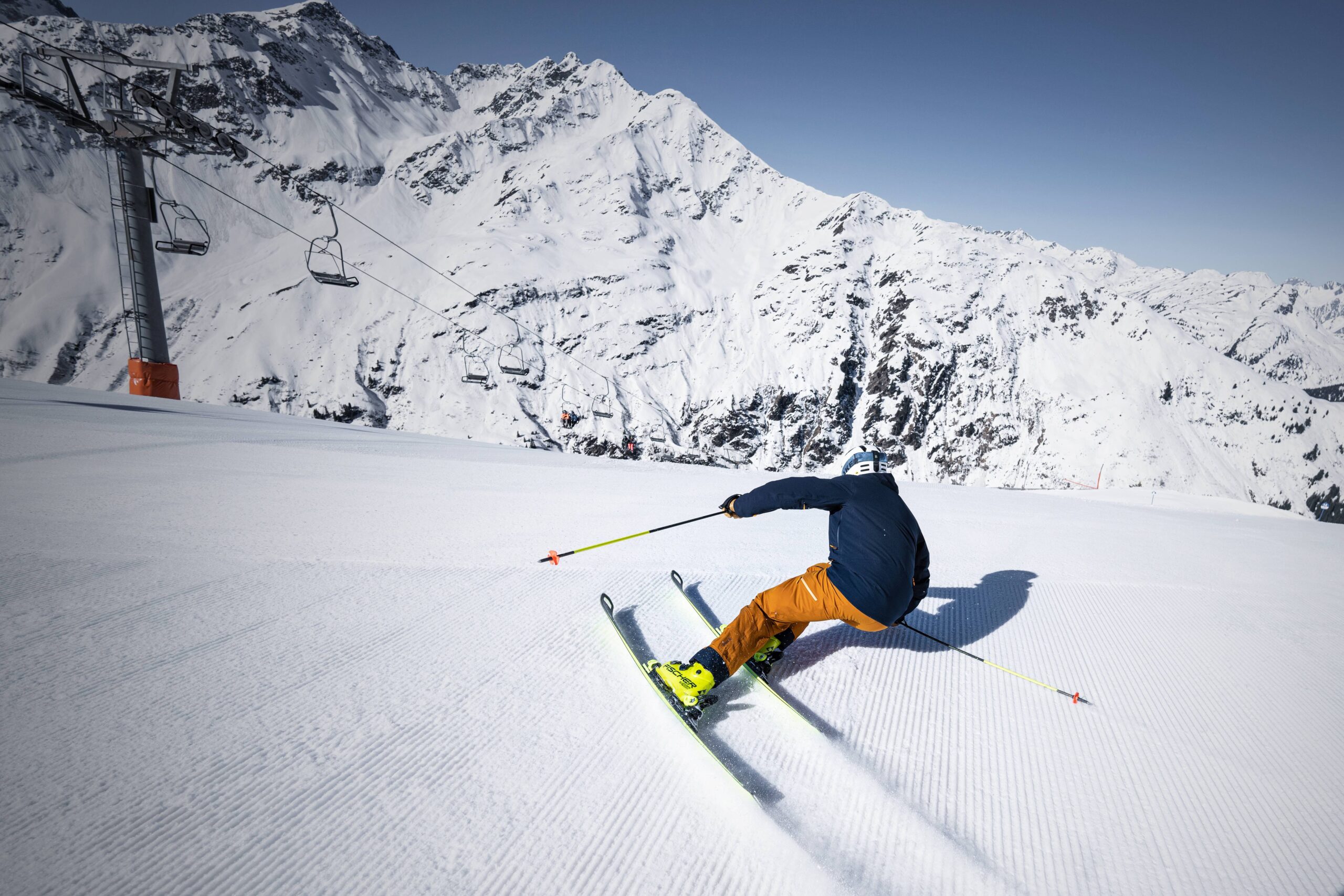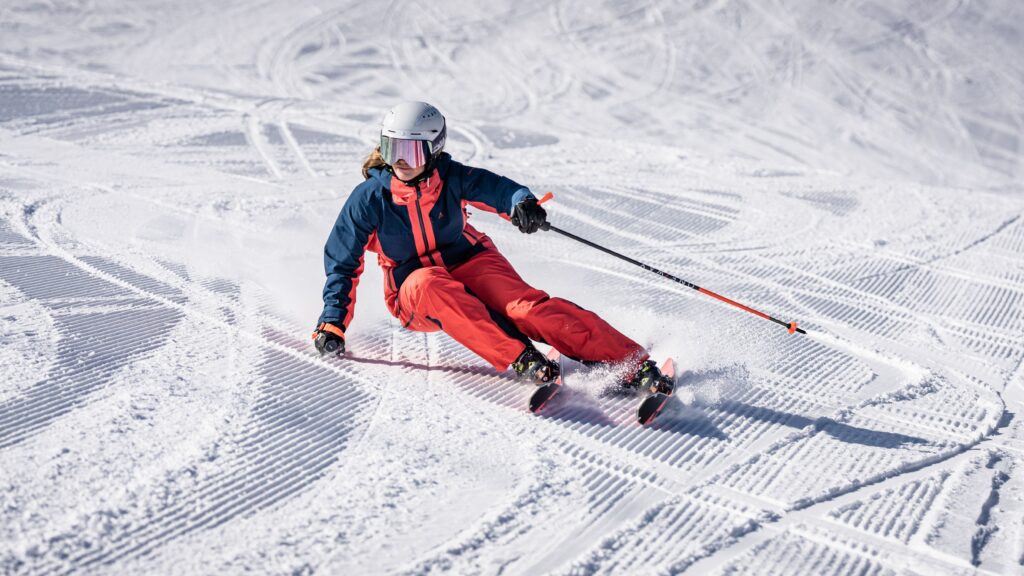Carving skills with Dave Ryding
He made sporting skiing history winning Britain's first Alpine World Cup gold. Here 'The Rocket' details three easy carving skills we can master in a day… and one badass drill that will take years to master


When carving, it’s important that you drop the urge to initiate each turn by manually turning, pointing or pivoting your feet and skis in the direction you want to turn. Instead, you let the skis do the turning for you. This drill is great for practicing this key technique.
Find a run that is not too steep, so that you feel confident to let the skis run a bit. Start sliding forward, with your skis facing down the fall line. Keep your shins in the front of your boot and a neutral stance, and resist the urge to make any movements with your feet or body that you ordinarily might do to get the turn started.
You will start to pick up speed. Often skiers are nervous about the fall line – they have the feeling they’re getting out of control too fast – so they rush it and force their skis or their bodies into the turn, which then leads to rotation and sliding – which is the opposite of what we want to achieve.
Know that you can take the skis out of the fall line in the second half of the turn, which will kill your speed, so you don’t need to worry about allowing the skis to accelerate a bit.
A good way to practice patience during this first part of the turn is to count. If you have the tendency to get nervous and rush it, count 1, 2, 3… before starting the second part of the turn.
When you feel the acceleration, start to edge the skis and look for the balance against the outside ski. The skis will start to turn. This seemingly trivial task is the first key to being able to master a carve turn.
In the second half of the turn, the skis will slow down. You want to let your body fall forward down the hill in the direction you want to go. You show commitment, let gravity pull you, get neutral and forward, and ready to step onto the new outside ski again.
If you want to kill more speed, then have more pressure on your edges in the second half of the turn, which will create a more rounded turn, slowing you down.
Stop, look back and expect those perfect deep trenches in the snow!
The next step is building up steering pressure earlier in the turn. If you want to go as fast as possible, then you want to have the main pressure around the apex of the turn. So in the next drill, we’ll focus on moving up and forward to feel the outside ski earlier, and to make sure that you are really on that outside ski, you will lift the inside ski.
Repeat drill number one. Start to edge the outside ski, feel the pressure built and then lift the tail of the inside to make sure you’re fully on the outside edge. Edge more, and then slowly put the inside ski down.
Staying on that outside ski for the whole of the turn will ensure you have more rounded turns with good steering and less skidding. Be sure to do this on a gentle run so as not to pick up too much speed – when we go slower we need to be more precise as we can’t rely on forces to cheat!
Be careful that when you put the inside ski down again, that you don’t fall back on it, causing the outside ski to skid. Keep it light – the outside ski is the boss, taking you around the arc. With the outset ski engaged and on the edge, you can decide how tight the turn is – do you want to edge a bit more and tighten the turn, or do you want to let it run in a bigger arc?
Once you have practiced the above drill at slower speeds, the next task it to increase your speed and play with the angulation. Remember that the key to getting closer to the ground is not about getting your hip closer to the ground, but to improve your feeling for edging and balancing on the outside ski; it is the grip of the outside ski and our ability to balance against it that helps us to achieve higher edge angles.
Find a steeper run and play with the forces and angulation/inclination. If you cannot get enough grip on the outside ski to give you the confidence to play more with inclination, then it usually means you are still too much over the inside ski. If this is the case, go back to drill number one and two.

First things first, if you cannot carve properly on two skis, don’t try to carve on one ski. Nothing good will come of it! So be sure you have practiced the above drills first and feel confident carving on two skis on all terrain.
So what is so hard about carving on one ski? When turning on your inside ski balancing becomes very difficult, as angulation cannot be used when inclining into the turn. Instead, you need to resort to banking, which is leaning into the turn without angulation and proper outside ski pressure.
– Simply keep one ski lifted up off the snow throughout the whole sequence when turning left and right. Do a number of turns and get a good rhythm going, and then swap to the other ski. Most people find they have a preferred leg, but be sure to switch between them.
– Once you are comfortable lifting one ski off the snow, it’s time to take it off. Be sure to choose a gentle slope. Note that losing the other ski will greatly affect your balance, not only due to the lack of the weight of the missing ski, but also because your boot might swing back and forth. Bend your knee and tuck your lifted boot back and close to your other boot. Skiers who typically have a wider stance will struggle more here, as they rely on the inside ski for balance more than skiers who have a close stance.
Try to get a good rhythm going.

Fischer RC4 Worldcup SL skis – They generate massive power with perfect edge transitions to feel like you’re skiing on rails. The ski complies with the FIS regulations and incorporates the new M-Plate for the ultimate in power transmission and acceleration.
Fischer Podium RD 150 boots – It delivers the reliable precision needed to reach the top step of the podium. The new RD1 cuff guarantees optimal power transmission to the ski, providing a progressive, controlled flex. The newly developed full-metal canting system and new buckle ensure minimal tolerances to handle every race course. The new AFZ leather liner with cork ankle inserts enables an improved fit and ultimate handling at top speeds.